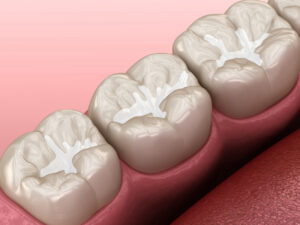
Composite fillings have become popular for dental restorations due to their natural appearance and durability. But have you ever wondered how composite fillings work? In this article, we will explore the science behind composite fillings and how they function to restore and protect teeth.
Composition Of Composite Fillings:
Composite fillings, also known as tooth-colored fillings, are made of a combination of materials. The main component is a resin matrix, typically composed of a blend of acrylic and a polymerizable monomer. This resin matrix provides the filling with its strength and durability. Additionally, the composite material contains fillers such as glass or ceramic particles, which reinforce the filling and enhance its aesthetic properties to match the tooth’s natural color.
Bonding Process:
One of the key aspects of composite fillings is their ability to bond directly to the tooth structure. This is achieved through a process known as adhesive bonding. The tooth is prepared by removing any decayed or damaged portions, creating a clean and stable surface. The tooth surface is then etched with an acidic gel to create micro-irregularities that improve the bonding strength. Next, a bonding agent is applied to the tooth surface. The composite filling material is carefully placed in layers and shaped to restore the natural contours of the tooth. Each layer is cured using a special light that activates the polymerization process, hardening the composite material and bonding it to the tooth.
Light-Curing Process:
The light-curing process is a critical step in the placement of composite fillings. The composite material contains a photoinitiator activated by a specific wavelength of light. When the dental curing light is applied to the composite material, the photoinitiator triggers a chemical reaction, causing the composite to harden and solidify. This process is highly advantageous as it allows the dentist to control the curing time and ensures that the filling material sets only when desired. Additionally, using a curing light allows for efficient and precise placement of the composite material.
Functionality And Strength:
Composite fillings not only restore the appearance of a tooth but also provide functional benefits. The composite material closely mimics the natural tooth structure, offering excellent strength and durability. It can withstand the forces of biting and chewing, providing long-lasting restorations. Composite fillings also have the advantage of being shaped and contoured during placement, allowing for precise restoration of the tooth’s natural anatomy and function.
Aesthetic Properties:
One of the significant advantages of composite fillings is their ability to blend seamlessly with the natural tooth color. The composite material can be custom-shaded to match the specific shade of the patient’s teeth, resulting in a virtually indistinguishable restoration from the surrounding tooth structure. This aesthetic property makes composite fillings an excellent choice for visible areas of the mouth, where a natural appearance is highly desired.
The Bottom Line
Composite fillings offer a scientifically advanced solution for dental restorations. Composite fillings’ composition, bonding process, light-curing mechanism, functionality, strength, and aesthetic properties all work together to provide durable, natural-looking restorations. Understanding the science behind composite fillings allows patients to appreciate the benefits and make informed decisions regarding their dental treatment options. Consult your dentist to determine if composite fillings are the right choice to restore and preserve your oral health.
